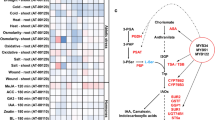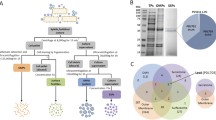Abstract
The sugar alcohol mannitol is an important carbohydrate with well-documented roles in both metabolism and osmoprotection in many plants and fungi. In addition to these traditionally recognized roles, mannitol is reported to be an antioxidant and as such may play a role in host–pathogen interactions. Current research suggests that pathogenic fungi can secrete mannitol into the apoplast to suppress reactive oxygen-mediated host defenses. Immunoelectron microscopy, immunoblot, and biochemical data reported here show that the normally symplastic plant enzyme, mannitol dehydrogenase (MTD), is secreted into the apoplast after treatment with the endogenous inducer of plant defense responses salicylic acid (SA). In contrast, a cytoplasmic marker protein, hexokinase, remained cytoplasmic after SA-treatment. Secreted MTD retained activity after export to the apoplast. Given that MTD converts mannitol to the sugar mannose, MTD secretion may be an important component of plant defense against mannitol-secreting fungal pathogens such as Alternaria. After SA treatment, MTD was not detected in the Golgi apparatus, and its SA-induced secretion was resistant to brefeldin A, an inhibitor of Golgi-mediated protein transport. Together with the absence of a known extracellular targeting sequence on the MTD protein, these data suggest that a plant’s response to pathogen challenge may include secretion of selected defensive proteins by as yet uncharacterized, non-Golgi mechanisms.








Similar content being viewed by others
Abbreviations
- BFA:
-
Brefeldin A
- HK:
-
Hexokinase
- JA:
-
Jasmonic acid
- MTD:
-
Mannitol dehydrogenase
- PCR:
-
Polymerase chain reaction
- PR:
-
Pathogenesis related
- ROS:
-
Reactive oxygen species
- SA:
-
Salicylic acid
References
An G (1985) High efficiency transformation of cultured tobacco cells. Plant Physiol 79:568–570
Backhaus R, Zehe C, Wegehingel S, Kehlenbach A, Schwappach B, Nickel W (2004) Unconventional protein secretion: membrane translocation of FGF-2 does not require protein unfolding. J Cell Sci 117:1727–1736
Bestwick CS, Brown IR, Mansfield JW (1998) Localized changes in peroxidase activity accompany hydrogen peroxide generation during the development of a nonhost hypersensitive response in lettuce. Plant Physiol 118:1067–1078
Bieleski RL (1982) Sugar alcohols. In: Loewus FA, Tanner W (eds) Encyclopedia of plant physiology, vol New series 13A. Springer, New York, pp 158–192
Bolwell GP, Bindschedler LV, Blee KA, Butt VS, Davies DR, Gardner SL, Gerrish C, Manibayeva F (2002) The apoplastic oxidative burst in response to biotic stress in plants: a three component system. J Exp Bot 53:1367–1376
Carrington CC (1995) Targeting of proteins to the nucleus. Methods Cell Biol 50:283–294
Chaturvedi V, Flynn T, Niehaus W, Wong B (1996a) Stress tolerance and pathogenic potential of a mannitol mutant of Cryptococcus neoformans. Microbiology 142:937–943
Chaturvedi V, Wong B, Newman SL (1996b) Oxidative killing of Cryptococcus neoformans by human neutrophils: evidence that fungal mannitol protects by scavenging reactive oxygen intermediates. J Immunol 156:3836–3840
Cleves AE (1997) Protein transport: the nonclassical ins and outs. Curr Biol 7:R318–R320
Davies DR, Bindschedler LV, Strickland TS, Bolwell GP (2006) Production of reactive oxygen species in Arabidopsis thaliana cell suspension cultures in response to an elicitor from Fusarium oxysporum: implications for basal resistance. J Exp Bot 57:1817–1827
Diaz-Vivancos P, Rubio M, Mesonero V, Periago PM, Barceló AR, Martínez-Gómez P, Hernández JA (2006) The apoplastic antioxidant system in Prunus: response to long-term plum pox virus infection. J Exp Bot 57:3813–3824
Doehlert D, Kuo T, Felker C (1988) Enzymes of sucrose and hexose metabolism in developing kernels of two inbreds of maize. Plant Physiol 86:1013–1019
Doran PM (2006) Foreign protein degradation and instability in plant and plant tissue cultures. Trends Biotechnol 24:426–432
Fecht-Christoffers MM, Führs H, Braun H-P, Horst WJ (2006) The role of hydrogen peroxide-producing and hydrogen peroxide-consuming peroxidases in the leaf apoplast of cowpea in manganese tolerance. Plant Physiol 140:1451–1463
Felle HH, Herrmann A, Hanstein S, Hückelhoven R, Kogel KH (2004) Apoplastic pH signaling in barley leaves attacked by the powdery mildew fungus Blumeria graminis f. sp. Hordei. Mol Plant Microbe Interact 17:118–123
Graham TL, Graham MY (1999) Role of hypersensitive cell death in conditioning elicitation competency and defense potentiation. Physiol Mol Plant Path 55:13–20
Grant M, Lamb C (2006) Systemic immunity. Curr Opin Plant Biol 9:414–420
Hernández JA, Ferrer MA, Jiménez A, Barceló AR, Sevilla F (2001) Antioxidant systems and O2 ·–/H2O2 production in the apoplast of pea leaves; its relation with salt-induced necrotic lesions in minor veins. Plant Physiol 127:817–831
Hood EE, Gelvin SB, Melchers LS, Hoekema A (1993) New Agrobacterium helper plasmids for gene-transfer to plants. Transgenic Res 2:208–218
Isaacson T, Rose JKC (2006) Surveying the plant cell wall proteome. In: Finnie C (ed) Plant proteomics. Blackwell, Kongens Lyngby, pp 185–209
Jamet E, Canut H, Boudart G, Pont-Lezica RF (2006) Cell wall proteins: a new insight through proteomics. Trends Plant Sci 11:33–39
Jarvik JW, Telmer CA (1998) Epitope tagging. Annu Rev Genet 32:601–618
Jennings DH (1984) Polyol metabolism in fungi. Adv Microb Physiol 25:149–193
Jennings DB, Ehrenshaft M, Pharr DM, Williamson JD (1998) Roles for mannitol and mannitol dehydrogenase inactive oxygen-mediated plant defense. Proc Natl Acad Sci USA 95:15129–15133
Jennings DB, Daub ME, Pharr DM, Williamson JD (2002) Constitutive expression of a celery mannitol dehydrogenase in tobacco enhances resistance to the mannitol-secreting fungal pathogen Alternaria alternata. Plant J 32:41–49
Joosten MHAJ, Hendrickx LJM, De Wit PJGM (1990) Carbohydrate composition of apoplastic fluids isolated from tomato leaves inoculated with virulent or avirulent races of Cladosporium fulvum (syn. Fulvia fulva). Eur J Plant Pathol 96:103–112
Juchaux-Cachau M, Landouar-Arsivaud L, Pichaut J-P, Campion C, Porcheron B, Jeauffre J, Noiraud-Romy N, Simoneau P, Maurousset L, Lemoine R (2007) Characterization of AgMaT2, a plasma membrane mannitol transporter from celery, expressed in phloem cells, including phloem parenchyma cells. Plant Physiol 145:62–74
Karpinska B, Karlsson M, Schinkel H, Streller S, Süss K-H, Melzer M, Wingsle G (2001) A novel superoxide dismutase with a high isoelectric point in higher plants; expression, regulation, and protein localization. Plant Physiol 126:1668–1677
Kiedrowski S, Kawalleck P, Hahlbrock K, Somssich IE, Dangl JL (1992) Rapid activation of a novel plant defense gene is strictly dependent on the Arabidopsis RPM1 disease resistance locus. EMBO J 11:4677–4684
Laemmli UK (1970) Cleavage of structural proteins during the assembly of the head of bacteriophage T4. Nature 227:680–685
Lamb C, Dixon RA (1997) The oxidative burst in plant disease resistance. Annu Rev Plant Physiol Plant Mol Biol 48:251–275
Loescher WH, Everard JD (2000) Metabolism of carbohydrates in sinks and sources: sugar alcohols. In: Zamski E, Schaffer A (eds) Distribution of photoassimilates in plants and crops: source-sink relationships. Marcel Dekker, New York, pp 185–207
Murashige T, Skoog FK (1962) A revised medium for rapid growth and bioassays with tobacco tissue cultures. Physiol Plant 15:473–497
Nebenfuhr A, Ritzenthaler C, Robinson DG (2002) Brefeldin A: deciphering an enigmatic inhibitor of secretion. Plant Physiol 130:1102–1108
Nickel W (2003) The mystery of nonclassical protein secretion; a current view on cargo proteins and potential export routes. Eur J Biochem 270:2109–2119
Nickel W (2005) Unconventional secretory routes: direct protein export across the plasma membrane of mammalian cells. Traffic 6:607–614
Oh IS, Park AR, Bae MS, Kwon SJ, Kim YS, Lee JE, Kang NY, Lee S, Cheong H, Park OK (2005) Secretome analysis reveals an Arabidopsis lipase involved in defense against Alternaria brassicicola. Plant Cell 17:2832–2847
Orci L, Tagaya M, Amherdt M, Perrelet A, Donaldson JG, Lippincott-Schwartz J, Klausner RD, Rothman JE (1991) Brefeldin A, a drug that blocks secretion, prevents the assembly of non-clathrin-coated buds on Golgi cisternae. Cell 64:1183–1195
Patykowski J, Urbanek H (2003) Activity of enzymes related to H2O2 generation and metabolism in leaf apoplastic fraction of tomato leaves infected with Botrytis cinerea. J Phytopathol 151:153–161
Raikhel N (1992) Nuclear targeting in plants. Plant Physiol 100:1627–1632
Rubartelli A, Cozzolino F, Talio M, Sitia R (1990) A novel secretory pathway for interleukin-1 beta, a protein lacking a signal sequence. EMBO J 9:1503–1510
Schnarrenberger C (1990) Characterization and compartmentation in green leaves, of hexokinases of different specificities of glucose, fructose, and mannose and for nucleoside triphosphates. Planta 181:249–255
Shen B, Jensen RG, Bohnert HJ (1997a) Increased resistance to oxidative stress in transgenic plants by targeting mannitol biosynthesis to the chloroplast. Plant Physiol 113:1177–1183
Shen B, Jensen RG, Bohnert HJ (1997b) Mannitol protects against oxidation by hydroxyl radicals. Plant Physiol 115:527–532
Silver PA (1991) How proteins enter the nucleus. Cell 4:489–497
Slabas A, Ndimba B, Simon W, Chivasa S (2004) Proteomic analysis of the Arabidopsis cell wall reveals unexpected proteins with new cellular locations. Biochem Soc Trans 32:524–528
Smirnoff N, Cumbes QJ (1989) Hydroxyl radical scavenging activity of compatible solutes. Phytochemistry 28:1057–1060
Staehelin LA, Driouich A (1997) Brefeldin A effects in plants. Plant Physiol 114:401–403
Stoop JMH, Williamson JD, Conkling MA, Pharr DM (1995) Purification of NAD-dependent mannitol dehydrogenase from celery suspension cultures. Plant Physiol 108:1219–1225
Stoop JMH, Williamson JD, Pharr DM (1996) Mannitol metabolism in plants: a method for coping with stress. Trends Plant Sci 1:139–144
Streller S, Wingsle G (1994) Pinus sylvestris (L.) needles contain extracellular Cu/Zn superoxide dismutase. Planta 192:195–201
Thomas JC, Sepahi M, Arendall B, Bohnert HJ (1995) Enhancement of seed germination in high salinity by engineering mannitol expression in Arabidopsis thaliana. Plant Cell Environ 18:801–806
Vanacker H, Carver T, Foyer CH (1998) Pathogen-induced changes in the antioxidant status of the apoplast in barley leaves. Plant Physiol 117:1103–1114
Vélëz H, Glassbrook NJ, Daub ME (2007) Mannitol metabolism in the phytopathogenic fungus Alternaria alternata. Fungal Genet Biol 44:258–268
Vélëz H, Glassbrook NJ, Daub ME (2008) Mannitol biosynthesis is required for plant pathogenicity by Alternaria alternata. FEMS Microbiol Lett 285:122–129
Voegele RT, Hahn M, Lohaus G, Link T, Heiser I, Mendgen K (2005) Possible roles for mannitol and mannitol dehydrogenase in the biotrophic plant pathogen Uromyces fabae. Plant Physiol 137:190–198
Vranová E, Inzé D, Van Breusegem F (2002) Signal transduction during oxidative stress. J Exp Bot 53:1227–1236
Watson ME (1984) Compilation of published signal sequences. Nucleic Acids Res 12:5145–5164
Williamson JD, Stoop JMH, Massel MO, Conkling MA, Pharr DM (1995) Sequence analysis of a mannitol dehydrogenase cDNA from plants reveals a function for the PR protein ELI3. Proc Natl Acad Sci USA 92:7148–7152
Williamson JD, Jennings DB, Ehrenshaft M, Guo W-W, Pharr DM (2002) Sugar alcohols, salt stress, and fungal resistance: polyols-multifunctional plant protection. J Amer Soc Hort Sci 127:467–473
Yamamoto YT, Zamski E, Williamson JD, Conkling MA, Pharr DM (1997) Subcellular localization of celery mannitol dehydrogenase: a cytoplasmic metabolic enzyme in nuclei. Plant Physiol 115:1397–1403
Yamamoto YT, Prata RTN, Williamson JD, Weddington M, Pharr DM (2000) Formation of a hexokinase complex is associated with changes in energy utilization in celery organs and cells. Physiol Plant 110:28–37
Zamski E, Yamamoto YT, Williamson JD, Conkling MA, Pharr DM (1996) Immunolocalization of mannitol dehydrogenase in celery plants and cells. Plant Physiol 112:931–938
Zamski E, Guo W-W, Yamamoto YT, Pharr DM, Williamson JD (2001) Analysis of celery (Apium graveolens) mannitol dehydrogenase (Mtd) promoter regulation in Arabidopsis suggests roles for MTD in key environmental and metabolic responses. Plant Mol Biol 47:621–631
Acknowledgments
We thank Drs. Steven Spiker (NC State University, Genetics) for NT1 cultures, Jen Sheen (Harvard Medical School) for HK antiserum, Dan Klessig (Boyce Thompson Institute) for PR1a antiserum, and Drs. Candace Haigler (NC State University, Crop Science and Plant Biology) and Marcela Rojas-Pierce (NC State University, Plant Biology) for critical discussion and helpful comments. TEM analyses were conducted at the NCSU Center for Electron Microscopy. This work was supported in part by US Department of Agriculture—National Research Initiative grant no. 2000-0884 to JDW and DMP.
Author information
Authors and Affiliations
Corresponding author
Electronic supplementary material
Below is the link to the electronic supplementary material.
Rights and permissions
About this article
Cite this article
Cheng, Fy., Zamski, E., Guo, Ww. et al. Salicylic acid stimulates secretion of the normally symplastic enzyme mannitol dehydrogenase: a possible defense against mannitol-secreting fungal pathogens. Planta 230, 1093–1103 (2009). https://doi.org/10.1007/s00425-009-1006-3
Received:
Accepted:
Published:
Issue Date:
DOI: https://doi.org/10.1007/s00425-009-1006-3




